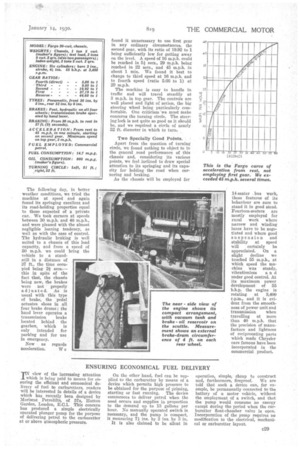On the Road with the FARGO CHASSIS
Page 50

Page 51

If you've noticed an error in this article please click here to report it so we can fix it.
The Chrysler built 30-cwt. Chassis Strenuously Tested With More Than Its Schedule Load
THE first appearance of Chrysler Motors, Ltd., of Kew Gardens, Surrey, in the field of commercial vehicles was made at the Commercial Motor Exhibition held at Olympia last November, the first of the Fargo 30-cwt. models arriving from the works just in time for the Show. A smaller type for 15-cwt. loads will shortly be available, but in the meantime we have taken the opportunity for subjecting to a strenuous test one of the larger models.
The weight of the bigger chassis is 25 cwt. and, with a body allowance of 10 cwt., it is scheduled to carry 00 cwt. of goods, making the gross laden weight 3 tons 5 cwt. The chassis will carry a 14-seater passenger body, the weight of which would be about one ton, the full load of passengersamounting, also,
to about one ton. Thus the anticipated laden weight, whether for-passenger or for goods service, is 3ietons. The chassis we tatted weighed 50 lb. in excess of this figure and carried two passengers as well as the driver. There was thus an overload of approximately 3 cwt.
When driving a six-cylinder chassis of this kind with a powertunit of even torque and high speed, one is inclined to expect private-car performance. This, of course, one doestnot get, but in the case of the Fargo the performance was almost equal to that of the modern sixcylinder motorcar in spite of the heavy load carried.
Performance on Severe Gradients.
Setting out from London, we took a favourite route of ours up the West
Hill, Highgate, the final gradient of which is about 1 in 6. We had to change to third gear fairly early on the hill and the major portion of the climb was made on second gear, the lowest speed (on the severest section near the crest of the hill) being 14 m.p.h. Out on the Barnet. by-pass we were caught in a sudden deluge of rain and were obliged to travel through it over a slippery asphalt road and then along a track through some very soft clay with many pot-holes. The reluctance of the loaded chassis to skid on the good slippery surface and its stability and tractive power when, tackling the soft clay were remarkably good. So far as skidding is concerned, we attribute the steadiness largely to the equal acting of the hydraulic brake system on all four wheels.
The following day, in better weather conditions, we tried the machine at speed and again found its springing excellent and its road-holding properties equal to those expected of a private car. We took corners at speeds between 30 m.p.h. and 40 m.p.h., and were pleased with the almost negligible leaning tendency, as well as with the ease of control. The hydraulic braking is well suited to a chassis of this load capacity, and from a speed of 30 m.p.h. we could bring the vehicle to a standstill in a distance of 37 ft., the time occupied being 21 sees.— this in spite of the fact that, the chassis being new, the brakes were not properly adjusted. As is usual with this type of brake, the pedal actuates shoes in all four brake drums ; the hand lever operates a transmission brake located behind the gearbox, which is only intended for parking and for use in emergency.
Now as regards acceleration. W e
found it unnecessary to use first gear in any ordinary circumstances, the second gear, with its ratio of 19.92 to 1 being sufficiently low for getting away on the level. A speed of 16 m.p.h. could be reached in 5i secs., 29 m.p.h. being reached in 22 secs., and 45 m.p.h. in about 1 min. We found it best to change to third speed at 16 m.p.h and to fourth speed (ratio 5.6(i to 1) at 29 m.p.h.
The machine is easy to handle in traffic and will travel steadily at 3 m.p.h. in top gear. The controls are well placed and light of action, the big steering wheel being particularly comfortable. One criticism 'we must make concerns the turning circle. The steering lock is not quite so good as it should be, and we required a circle of nearly 52 ft. diameter in which to turn. _ Two Specially Good Points.
Apart from the question of turning circle, we found nothing to object to in the general road performance of this chassis and, considering its various points, we feel inclined to draw special attention to its springing and its capacity for holding the road when cornering and braking.
As the chassis will be employed for 14-seater -bus work, these features of its behaviour are sure to stand it in good stead. Fourteen-seaters are mostly employed for rural work where narrow and winding lanes have to be negotiated and where good suspension and stability at speed will certainly be appreciated. On a slight decline we touched 55 m.p.h., at which speed the machine was steady, vibrationless a it d under good control. At its maximum power development of 55 b.h.p. the engine is rotating at 8,400 r.p.m., and it is evident from the smoothness of power unit and transmission when travelling at more than 40 m.p.h. that the precision of manufacture and lightness of reciprocating parts which made Chrysler cars famous have been incorporated in the commercial product.












































































































